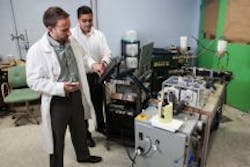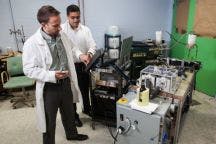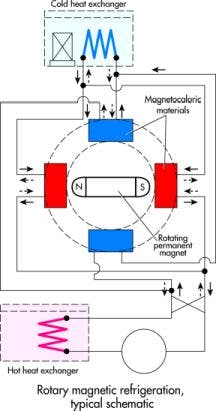The traditional vapor-compression cycle used in refrigeration may be relegated to the history books if researchers are right about magnetic (magnetocaloric) refrigeration. At least one major appliance maker plans to commercialize magnetic refrigeration for use in the home. The rationale for the change is that the technology uses no refrigerants or compressors and is said to be 20% more efficient than conventional techniques. It could also work well in HVAC.
The potential energy efficiency of magnetic refrigeration has made it the subject of serious study for quite some time. The Dept. of Energy's ARPA-E research program, for example, has made grants to several organizations pursuing the idea. One Dept. of Energy grant went to appliance maker GE which recently unveiled plans to produce magnetic regrigerators for ordinary consumers by 2020. Other entities such as the Astronautics Corp. of America and Iowa State University's Ames Lab have also devised magnetic refrigeration schemes.
The underlying phenomenon used for magnetic refrigeration was first observed by the German physicist Emil Warburg in the 1880s. The magnetocaloric effect (MCE, from magnet and calorie) takes place when a special kind of material is exposed to a strong magnetic field. The magnetic field constrains the orientation of magnetic dipoles in the material. The stronger the magnetic field, the more aligned the dipoles. This state corresponds to lower entropy and heat capacity because the material has (effectively) lost some of its internal degrees of freedom. Thus the material gives off heat under the influence of the magentic field.
Switching off the magnetic field lets the heat capacity of the material rise because the dipoles become more disordered. As the dipoles become disordered, the material absorbs heat. Thus a refrigeration cycle can be comprised of pulling this special material in and out of a magnetic field and pairing it judiciously with a heat exchanger.
The usual way of devising practical refrigeration with magnetocaloric materials involves first forming the material as a hollow cylinder, then rotating magnets around the material while manipulating a heat-transfer fluid near it. For example, Chubu Electric Power Co., Inc., Nagoya, Japan produced a prototype fridge with a structure depicted in the accompanying diagram. Here, a 0.76-T permanent magnet rotates inside four magnetocaloric beds shaped as a cylinder, stopping momentarily to let the heat-transfer fluid flow before it moves to the next pair of beds. The beds contain Gd–Dy spheres. The heat-transfer fluid is an alcohol-water solution. The firm says the rotational frequency is 0.28 Hz.
There are a number of problems with making a practical refrigerator with this kind of setup. For one thing, few materials exhibit much of a magnetocaloric effect. One of the more widely used materials in this category is a rare earth called gadolinium and its alloys such as Gd5(Si2Ge2). But magnetocaloric materials tend to be expensive. Gadolinium, for example, typically costs thousands of dollars per pound. The quest for cheaper magnetocaloric materials is an active research topic. Manganese compounds such as MnFeP1-xAsx are among those being looked at.
Another difficulty is that the practical temperature change available from magnetocaloric materials tends to be small. For example, one research effort reports that application of a 2-Tesla magnetic field produced a 9ºF (~5°C) temperature change. In GE's recent announcement about its magnetic refrigeration work, researchers noted their prototype uses 50 stages to produce an 80º F temperature change, which works out to 1.6º per stage. GE says the commercial version it hopes to bring to market by 2020 will be capable of producing a 100º change.
Of course, one way to get higher temperature differentials is to boost the magnetic field. For example, researchers have used a 10-T field to produce temperature differentials of 45ºF. However, a 10-T field is on the scale of that used in medical MRI machines. Generating fields this large is problematic as they require expensive and power-sucking superconducting electromagnets.
Nevertheless, the consensus among appliance makers seems to be that the promise of magnetic refrigeration is worth the effort put into solving such problems. The technique not only promises potential energy savings, but also would eliminate chemical refrigerants such as Freon now used to transfer heat from inside the refrigerator. The heat transfer fluid GE aims to use in the machines it plans to debut in 2020 is based on ordinary water.
About the Author
Leland Teschler
Lee Teschler served as Editor-in-Chief of Machine Design until 2014. He holds a B.S. Engineering from the University of Michigan; a B.S. Electrical Engineering from the University of Michigan; and an MBA from Cleveland State University. Prior to joining Penton, Lee worked as a Communications design engineer for the U.S. Government.


